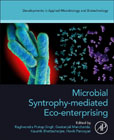
Microbial Syntrophy-mediated Eco-enterprising
Pratap Singh, Raghvendra
Manchanda, Geetanjali
Bhattacharjee, Kaushik
Panosyan, Hovik
Microbial Syntrophy-Mediated Eco-enterprising summarizes and reviews possible microbial applications for eco-industrial sustainability. The book emphasizes a wide spectrum of experimental and theoretical contributions from eminent researchers in the field. In 13 chapters, there is a focus on the microbial intrusions for remediating sites by accumulated pesticides, heavy metals, polyaromatic hydrocarbons, and other industrial effluents. Moreover, the potentiality and key mechanisms used by microorganisms for sustainable environmental management and their prospects are also considered in this new release. The term syntrophy for nutritional interdependence is often used in microbiology to describe the symbiotic relationship between bacterial species. Understanding such interactions can be of considerable interest when we come to manipulate microbes to our own benefit, such as by disrupting pathogenic communities with antibiotics or by promoting efficiency in communities that produce energy or break down waste. Summarizes and reviews possible microbial applications for eco-industrial sustainability Includes a wide spectrum of experimental and theoretical contributions from eminent researchers in the field Focuses on microbial intrusions for remediating sites and other industrial effluents INDICE: 1. Anabaena-azollae, significance and agriculture application: A case study for symbiotic cyanobacterium2. The bioremediation of agricultural soils polluted with pesticides and herbicides3. Multifunctional properties of polysaccharides produced by halophilic microorganisms and their new approaches in biotechnology4. Microorganisms in metal recovery - tools or teachers?5. Endophyte: A promising biostimulant to modulate secondary metabolites biosynthesis in plants6. Biotechnological Upgrading of Heavy Crude Oil7. Microbial approaches for amino acids production8. Pseudomonas for sustainable agricultural ecosystem9. Relationship between organic matter and microbial biomass in different types of vegetation10. Molecular mechanisms of stress adaptation by bacterial communities11. Synergism in microbial communities facilitate the biodegradation of pesticides12. Bioproduction of terpenoid aroma compounds by microbial cell factories13. Microbial mediated remediation of pesticides: A sustainable tool
- ISBN: 978-0-323-99900-7
- Editorial: Academic Press
- Encuadernacion: Rústica
- Páginas: 362
- Fecha Publicación: 14/02/2022
- Nº Volúmenes: 1
- Idioma: Inglés
